- Welcome to the Knowledge Base
- Introduction
- Training
- Getting Started
- Preferences
- Activities
- Cases
- Forecasts & Quotas
- Importing Data
- Leads
-
Marketing
- Introduction to Marketing
- Marketing Campaigns
- Mailing Lists
- Products
- Mailshots
- Upload Library
- Templates
- Event Management
- Compliance Records
-
Spotler Integration
- What is Spotler?
- Navigating your Spotler homepage
- GatorMail
-
GatorLeads / Web Insights
- Tracking Code
- Setting up the Plugin
- Viewing Web Insights Data on your Form Layouts
- Domain Names and Online Activities
- Reporting incorrect Leads created through Web Insights
- Reporting on Web Insights data
- Using UTM Values
- Why aren’t Online Activities being created in the database?
- Why is GatorLeads recording online activities in a foreign language?
- GatorSurvey
- GatorWorkflow
- GatorPopup
- Opportunities
-
Integrations
- Mapping
- Electronic Signing Tools
- Creditsafe Integration
-
Zapier
- Introduction to Zapier
- Available Triggers and Actions
- Linking your Workbooks Account to Zapier
-
Setting up Zaps
- Posted Invoices to Xero Invoices
- Xero payments to Workbooks Tasks
- New Case to Google Drive folder
- New Case to Basecamp Project
- New Workbooks Case to JIRA Ticket
- Jira Issue to new Case
- 123FormBuilder Form Entry to Case
- Eventbrite Attendee to Sales Lead and Task
- Facebook Ad Leads to Sales Leads
- Wufoo Form Entry to Sales Lead
- Posted Credit Note to Task
- QuickBooks Online
- Survey Monkey responses to Tasks
- Multistep Zaps
-
Email Integrations
- Email Dropbox
- Workbooks Exchange Server Sync
- Workbooks Outlook Connector
- RevenueGrid Intelligence and Engage
-
Event & Webinar Integration Tools
- GoToWebinar
- ON24
- Microsoft Office
-
Outreach
- Installation
- Outreach Authentication
- Sync People to Outreach Prospects
- Sync Organisations to Outreach Accounts
- Sync Workbooks Opportunities to Outreach
- Sync Tasks/Activities from Workbooks to Outreach
- Sync Outreach Sequences to Workbooks
- Sync Outreach Sequence States to Workbooks
- Sync Outreach Sequence Step Numbers to Workbooks
- Sync Prospects/Accounts/Opportunities from Outreach to Workbooks
- Sync Outreach Tasks/Calls/Meetings to Workbooks
- Scribe/Workbooks Connector
- RingCentral
- Auditing
- Comments
- People & Organisations
- Projects
-
Reporting
- Introduction to Reporting
- Using Reports
- Charts
- Exporting Reports
- Advanced Reporting
- Report Snapshots
- Dashboards
-
Transaction Documents
-
Introduction to Transaction Documents
- Displaying & Adding Transaction Documents
- Copying Transaction Documents
- Transaction Documents Fields Help
- Transaction Documents Line Items Help
- Printing & Sending Transaction Documents
- Managing Transaction Document Currencies
- Managing Transaction Document Statuses
- Setting a Blank Default Currency on Transaction Documents
- Credit Notes
- Customer Orders
- Invoices
- Quotations
- Supplier Orders
- Contract Management
- Sagelink
-
Introduction to Transaction Documents
- Auditing
-
Configuration
- Introduction to System Administration
- Users & Security
- Preferences
- Database
- Accounting
- Email & Integration
-
Customisation
- Creating & Modifying Picklists
- Theme
-
Record Types
- Creating Custom Fields
- Report-based Custom Fields
- Linked Fields & Reference Fields
- Record Templates
- Form Layouts
- Customising relationships between parties
- Opportunity Stages
- Custom Records
- Automation
- PDF Configuration
- Contact Support
- Releases & Roadmap
Report Card View
Landing Page Report Views & Card View within Reports
Card View can be used in within Reports.
Before switching over to Card View, within a report you need to make sure that all the fields you want to see in the Card are shown.

Once you have the report ready to go, you will need to switch from a report view to the Card View which can be done by clicking View on the top right of the Report, then select View as Cards. If the Card View has not been configured on the report before, the drag and drop editor will appear straight away. If it has been configured, it will show the view as a card. Follow the steps on the Landing Page Card View page to configure the cards how you want.

This example shows what the report can look like in Card View on the Single Card with Image option.

This example shows what the report can look like in Card View using the Single Card option and is configured the same way as a Landing Page report view (see t he link above).

A few things to note:
- Within the drag and drop editor for reports the 'Available Fields' are the names of the columns, and not field names. This means they can be edited specifically for a card view to show what you want.
- Underneath the 'Field Details' section on reports, another section will be shown named 'Report Options'. The checkbox shown will give you the option to 'Show grand totals', which then totals the column you want.
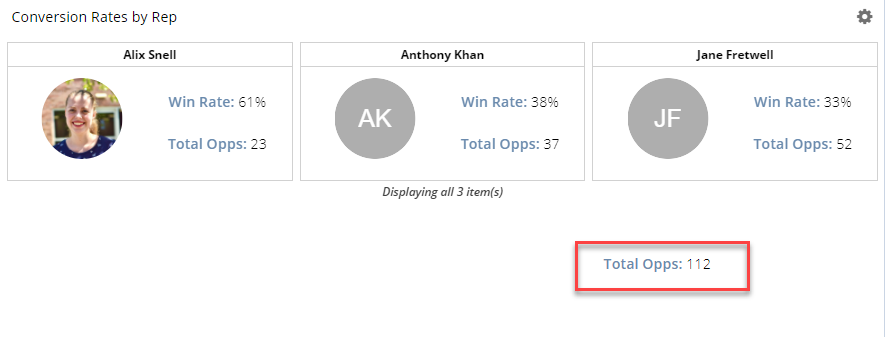
- Icons cannot be changed on reports to suit whichever record they a based on/drilling through to. The standard report icon will be shown as per above screenshots.
- Profile pictures can be added into a Card by adding the photo into the report.
Card View within Dashboards
Reports on Dashboards can also be edited to show cards.
Find the Report within the Dashboard you want to view as cards.
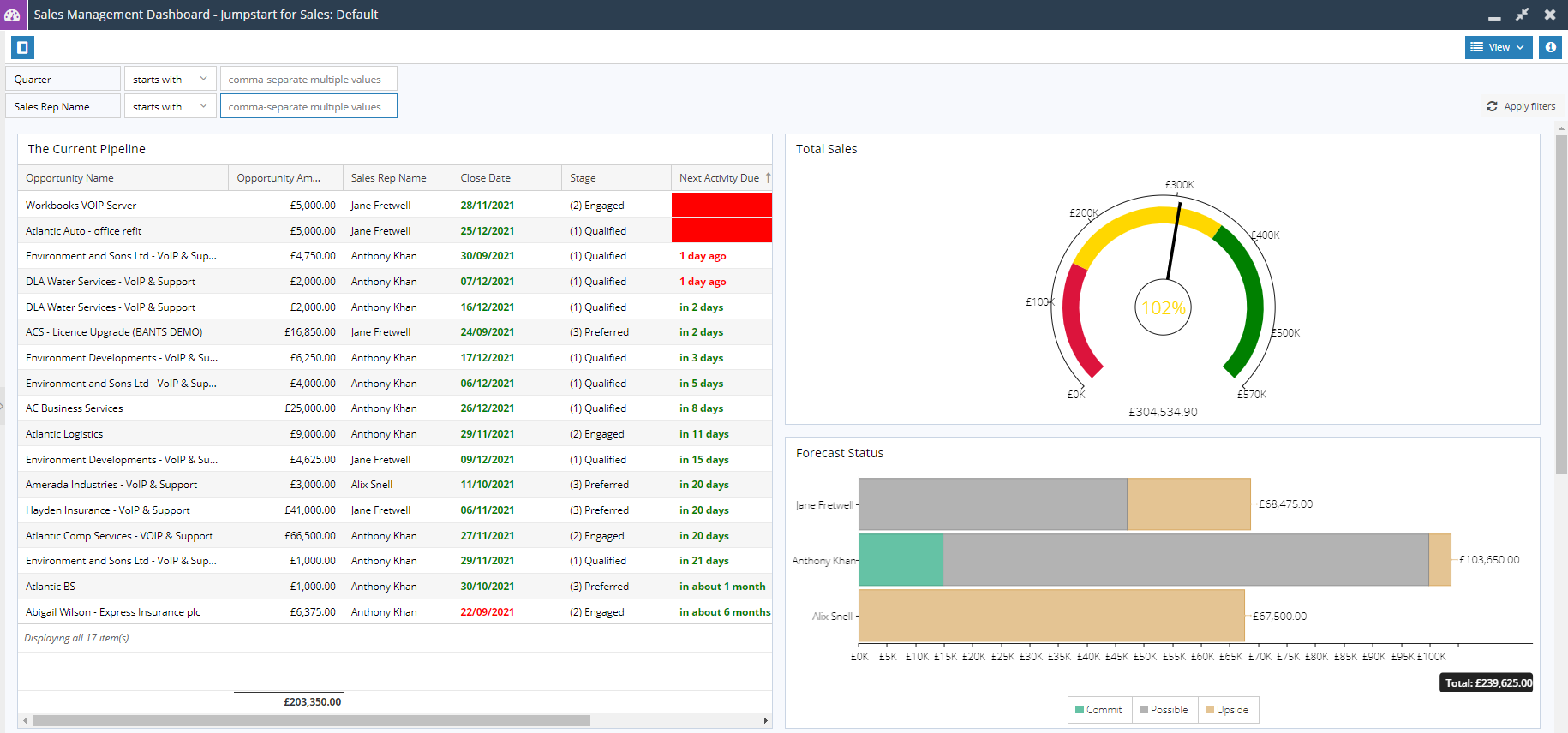
To change to Card View, you will need edit Permissions on the Dashboard. Within Edit mode, go into the Layout tab and hovering over the report you want to change will show a cog symbol, click on this. A new window will open, click on the Report tab, then within View you will be given the option to View as Cards.
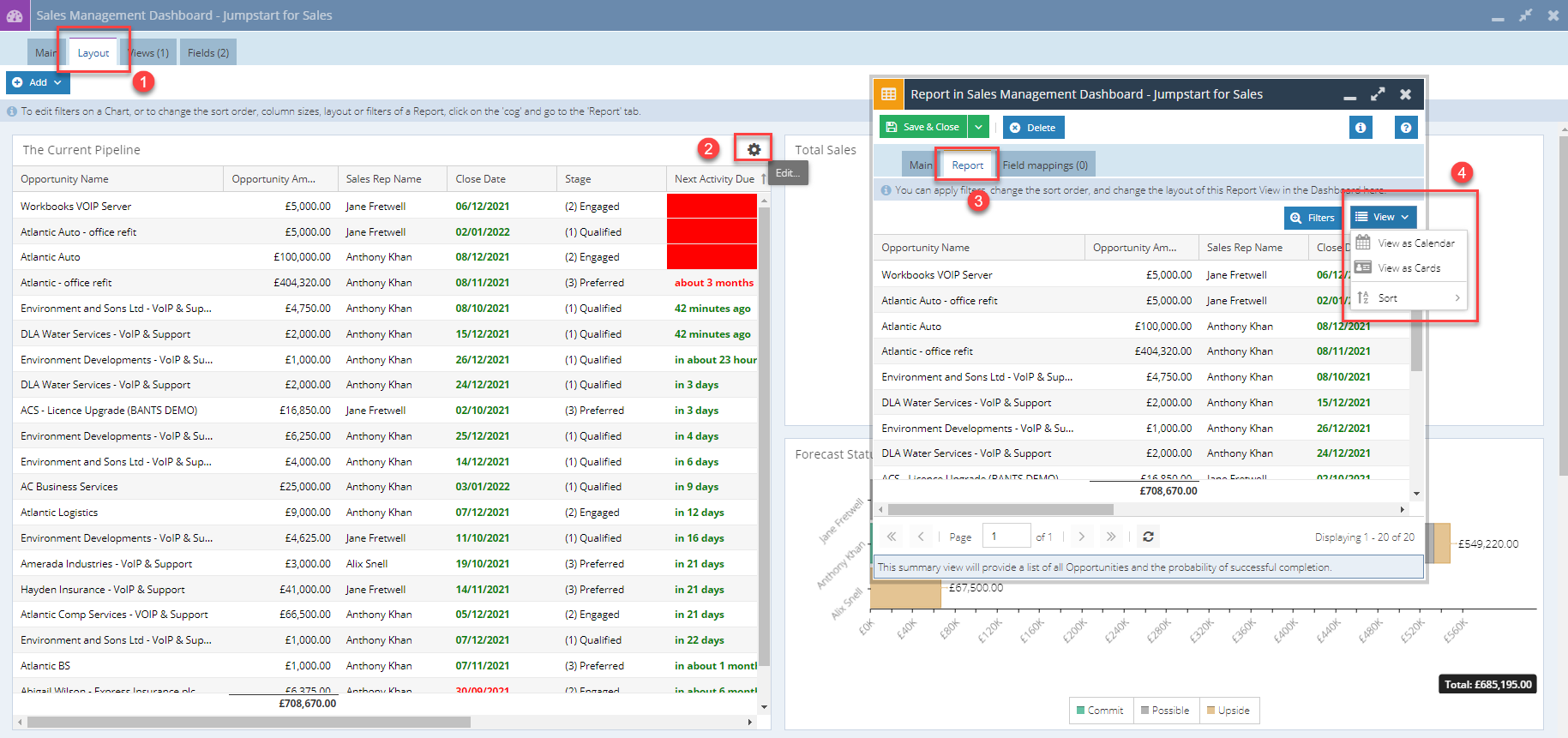
This example shows fields what the Dashboard can look like in Card View on the Multi-Card option.
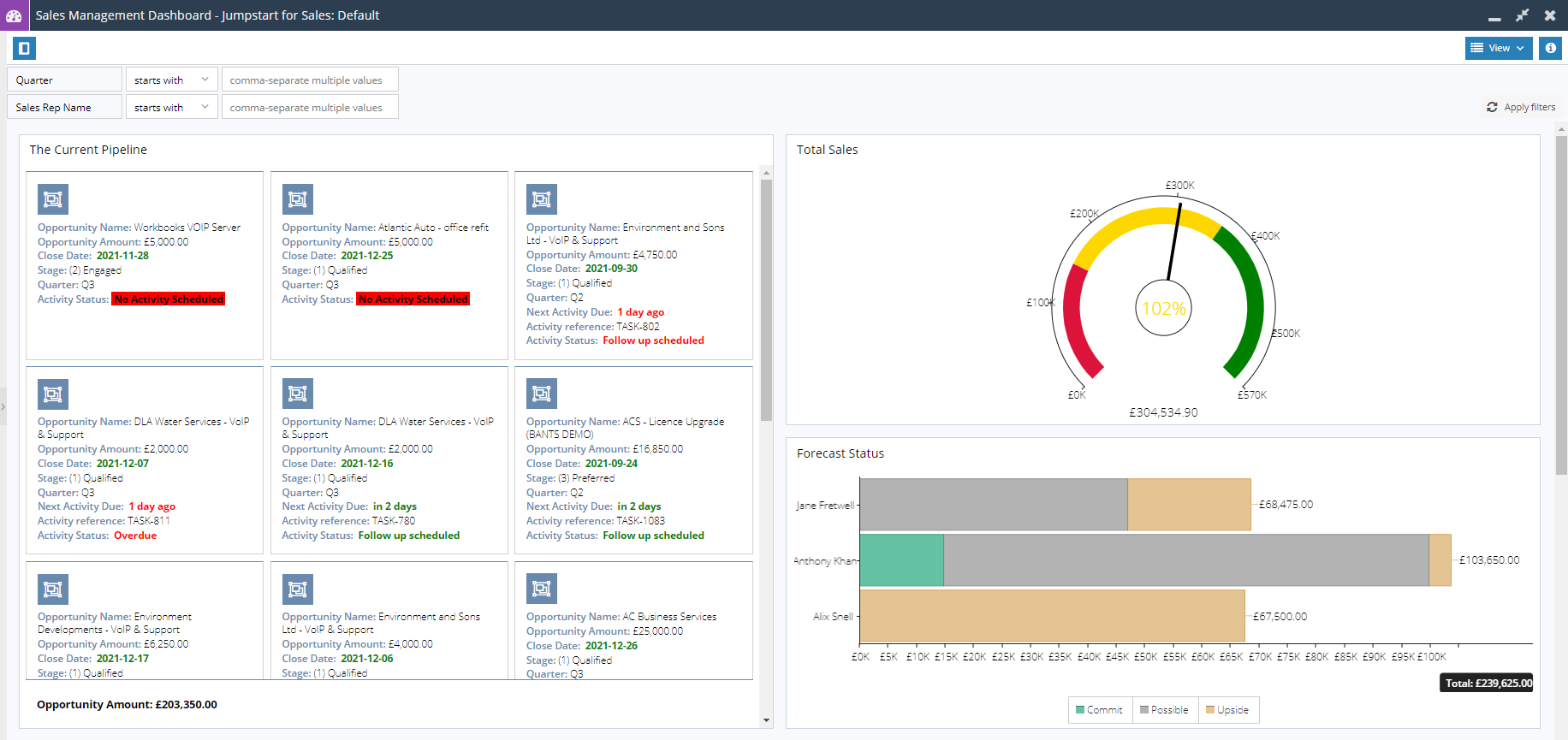
A few other examples of what options that can be used on Card View:
- Single Card with banner & image - the below example shows information on the Opportunities on the left columns and information on the latest Activity linked on the right. The banner at the top shows the status of the Activity in CSS styling, while the synopsis at the bottom gives you the description of that Activity. The image shown is the logo of the Organisation that is linked to the Opportunity, which if blank, will show the initials.
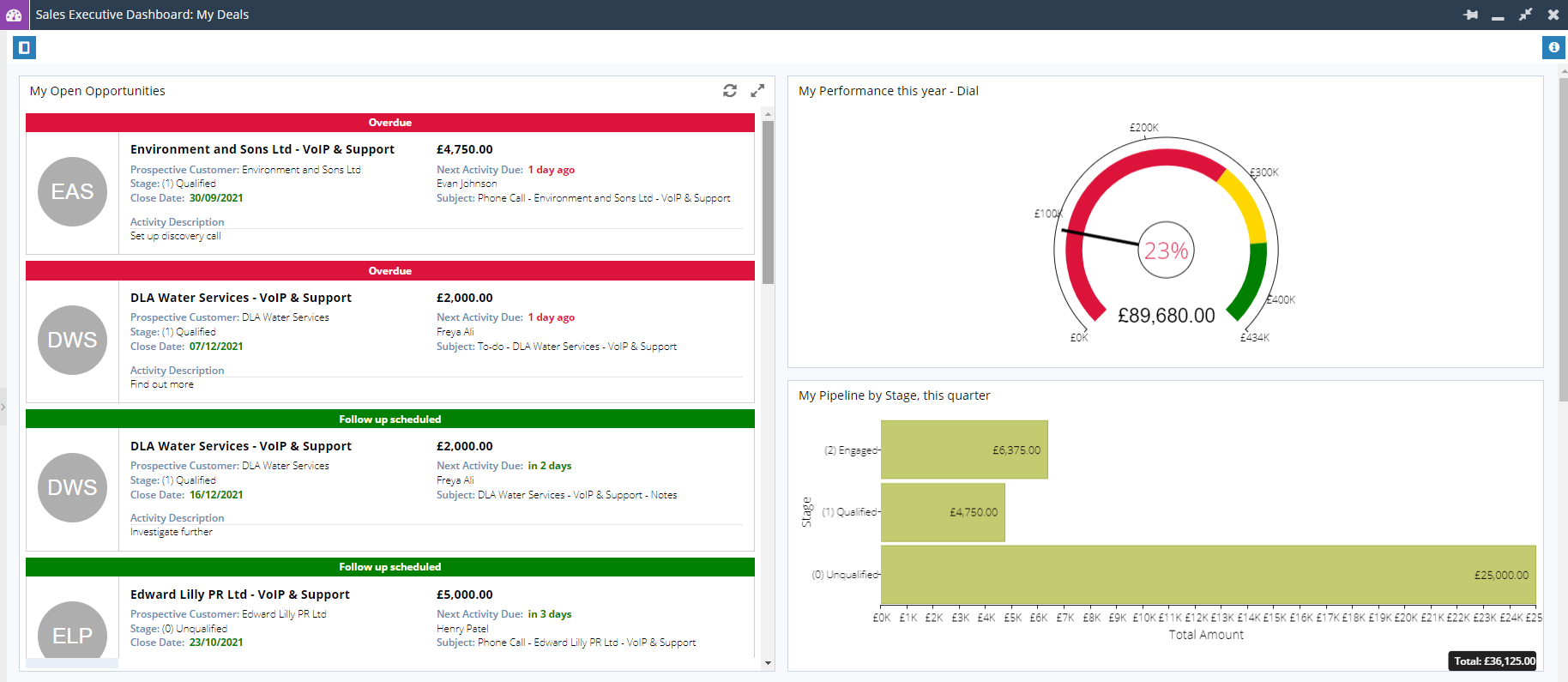
- Multi-Card with banner & image (centred) - the below example shows the actual performance of sales on Opportunities, compared to the target given to that User, with the User profile picture in the middle. The banner at the top is showing the CSS styling of a percentage of the two other fields shown, with the Users name at the bottom. As mentioned above, any of this fields can be changed, however, do need be in the report to be able to add to the card.


